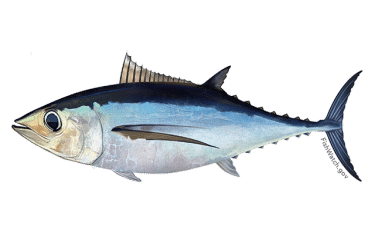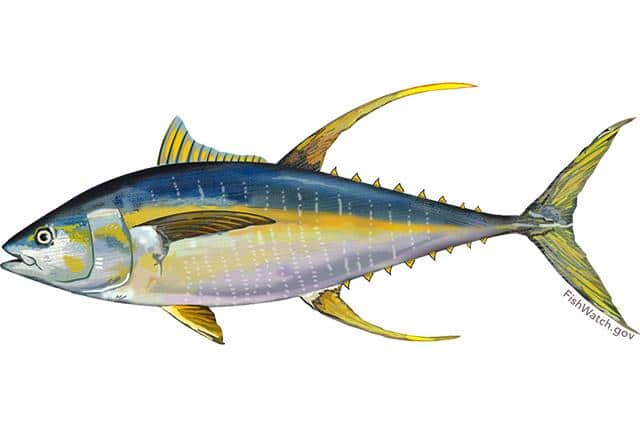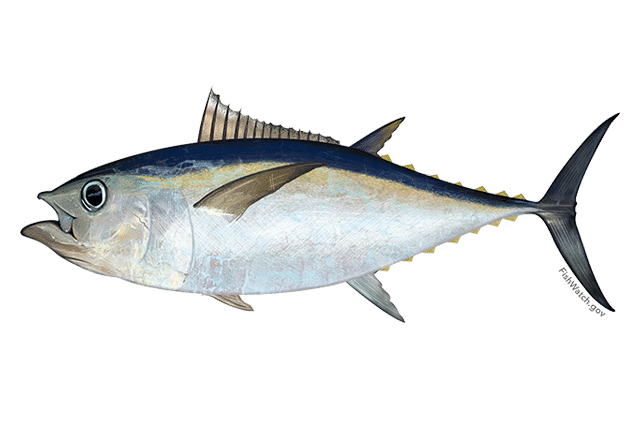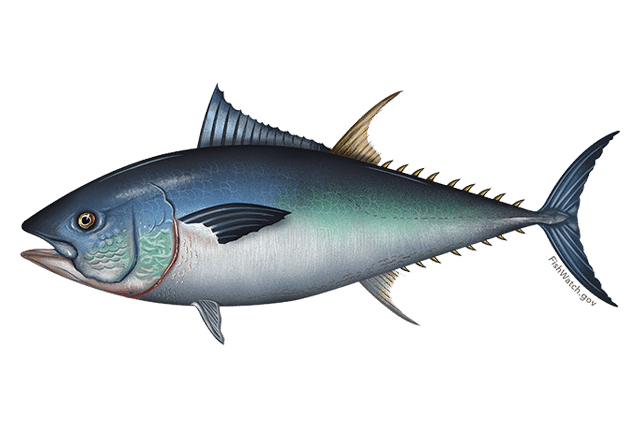
When you think of tuna do you think of that beige looking product found in a tin, or do you think about that glorious fish and the tender, rich meat that it provides? In this article we are only interested in fresh tuna caught out in the ocean, although to be fair your canned tuna did once swim in the ocean.
Tuna is not actually a single species of fish but covers as many as twelve different varieties of which five are mainly eaten in the Western World. They all have unique characteristics and are often found in different oceans. Whilst researching this article I have discovered that there is some crossover of names of Tuna between Europe and the United States.
As I am writing this based in France I will use the European and apologise to any Americans who may disagree with me!

Skipjack
The smallest and most abundant Tuna is Skipjack. If you have just opened a tin of tuna and mixed it with mayonnaise to slap in a sandwich then the chances are that it is Skipjack. They are relatively small in size, growing up to about 1 metre and weighing 20kg. Fortunately they have a very fast lifecycle and breed at a young age, so there is not much danger of a threat by overfishing, although it is the most widely fished tuna in the world. In France they are also known as “faux thon” or false tuna as they do not actually belong to the tuna family

Germon (White Tuna Thunnus Alalunga)
Extremely widely fished in virtually all oceans including the Mediterranean the white tuna is so called because of its pale flesh which is very pale rosé in colour. It is a fairly small tuna growing to just over 1 metre with à weight of 15 to 20 kg. Stocks are pretty good but it is advised not to over consume them from the Mediterranean or Pacific. It is often known as Albacore in English speaking regions.

Albacore (Thunnus Albacares)
The Albacore is also known in France as “thon jaune” (Yellow Tuna) but Yellow Fin Tuna in the rest of the World is not known as Albacore. This is a truly impressive fish growing up to 2 metres and often weighing 100kg, found in tropical and sub-tropical waters. The colour of the flesh is a deeper red than that of the Germon Tuna and has a mild but meaty flavour. Once cooked the flesh turns to a grayish colour not dissimilar to swordfish. Yellowfin can also be eaten raw as sashimi or sushi. Unfortunately it has been listed as “menaced” because of some over fishing in certain areas particularly the Indian Ocean. In the past too many young fish have been captured before having a chance to breed. A responsible fishmonger will be able to provide proper traceability.

Patudo (Big Eye Thunnus Obesus)
I simply love the name of this tuna – literally translated it means Fat Tuna. If that isn’t the name of my next restaurant…..! Also known in the USA as Big Eye Tuna. These fish can grow up to 2 metres and weigh a whopping 150kg living as long as 9 years in tropical and temperate oceans. They are very much prized for use as sashimi. But if you want to cook your tuna steak treat it à little like a fillet of beef. The flesh is firm and meaty with a relatively high fat content (more than yellowfin) so cook it rare or medium-rare leaving the beautiful deep pink colour in the middle. Unfortunately due to the popularity of the Big Eye it has been over fished but the US Fisheries is working to help conserve the species in the Atlantic.

Bluefin Tuna (Thon Rouge Thunnus Thynnus)
The Bluefin Tuna is split into three species depending on where they come from – Atlantic (which covers the Mediterranean), Pacific and Southern . The Bluefin is also described as the greatest fish in the ocean – large, fast and elegant. The biggest market for Bluefin is Japan, where it is sold as sashimi, which accounts for around 80% of the global market. Unlike other tuna this fish can live for as long as 40 years and measure 3 metres in length.
The flesh is a lovely deep red colour with a meaty texture. Again if you are cooking it be careful not to overcook it- rare/ medium-rare is sufficient. Unfortunately stocks of Pacific Bluefin are dangerously low, although with fishing quotas and stock management the forecast is looking better. Atlantic Bluefin came close to extinction but stocks have recovered and there is even talk of increasing quotas in the Mediterranean.
In terms of nutritional value tuna is extremely good for you. Full of protein and low in harmful fats but high in Omega 3 fats and low in sugar.. Tuna also contains an important source of creatine, a derivative of amino acid, effective in building muscle mass and present in the brain. Many top athletes eat tuna to help build muscle without excessive fat. One word of caution; some tuna can be high in mercury, so over consumption is not recommended.